The Fallen Cities: Difference between revisions
KestrelGirl (talk | contribs) mNo edit summary Tag: visualeditor |
KestrelGirl (talk | contribs) mNo edit summary Tag: visualeditor |
||
| Line 28: | Line 28: | ||
==The Second City, circa 1335 BCE== | ==The Second City, circa 1335 BCE== | ||
''"Never mention the Second City to the Masters of the Bazaar. Mr Wines will look at you narrowly and give you its worst vintage. Mr Cups will fly into a rage. Mr Veils will harangue you for your discourtesy. Mr Iron will say nothing, only write down your name with its left hand."'' | ''"Never mention the Second City to the Masters of the Bazaar. [[Mr Wines]] will look at you narrowly and give you its worst vintage. [[Mr Cups]] will fly into a rage. [[Mr Veils]] will harangue you for your discourtesy. [[Mr Iron]] will say nothing, only write down your name with its left hand."'' | ||
''"Certain of the Masters of the Bazaar - Mr Stones, Mr Apples and Mr Wines, and possibly others - seem to have a particular contempt for Egypt and the Egyptological. Perhaps they're simply reacting to the fashion for the Pharaonic that overcame London before the Descent. But it's unusual that they should care."'' | ''"Certain of the Masters of the Bazaar - [[Mr Stones]], [[Mr Apples]] and Mr Wines, and possibly others - seem to have a particular contempt for Egypt and the Egyptological. Perhaps they're simply reacting to the fashion for the Pharaonic that overcame London before the Descent. But it's unusual that they should care."'' | ||
[[File:Citytablet.png|thumb|100px|Relics from the Second City.]]''"...and the second betrayed..."''[[File:Ruinssecond.png|thumb|100px|Ruins of the Second City.]] | [[File:Citytablet.png|thumb|100px|Relics from the Second City.]]''"...and the second betrayed..."''[[File:Ruinssecond.png|thumb|100px|Ruins of the Second City.]] | ||
'''The Second City''' was Amarna, briefly the capital of ancient Egypt under Akhenaten. The remnants of the city live on in [[Visage]] and [[Arbor]]. | '''The Second City''' was Amarna, briefly the capital of ancient Egypt under Akhenaten. The remnants of the city live on in [[Visage]] and [[Arbor]]. | ||
Revision as of 01:33, 28 November 2021

|
The following page is not properly cited as per our revamped content policy. Therefore, the article may contain information from speculative or non-canon sources. You can find out more about our citation policy here. |

|
Beyond this point lie major spoilers for Fallen London, Sunless Sea, Sunless Skies, or Mask of the Rose. This may include endgame or major Fate-locked spoilers. Proceed at your own risk. You can find out more about our spoiler policy here. |
London is not the only city to have been brought down to the Neath. Four other cities came before it, all traded to the Bazaar for their own various reasons. Very few wish to consider the possibility of any coming after.
Traces of these former cities can be found throughout London. The Fourth City is the most present by far, as a remnant stands just outside the city: the Forgotten Quarter. London is also in frequent contact and rivalry with the Khanate, the floating city-state established by Fourth City refugees on the Unterzee.
The process of Falling a city is as follows: the Masters of the Bazaar arrive at a powerful and well-populated city and broker a deal with its rulers, which often involves a tale of love. After the deal is brokered, the old city is drowned in lacre,[1] killing nearly all of its inhabitants,[2] and the new one literally falls on top. The new city is then subjugated by the Bazaar, and business carries on as usual.
Extraordinary circumstances and the very impermanent nature of death in the Neath mean that certain people from the previous cities may survive long after their cities were crushed. The majority of these have left for the Tomb Colonies, however, as these cities stretch far back into antiquity. Anybody who could survive that long and still remain a part of Fifth City life is either incredibly wily, powerful, or simply useful.
The First City, date unknown
"Only two things are known to remain of the First City: the name, the Crossroads Shaded By Cedars, and the saying: even the First City was young when Babylon fell."
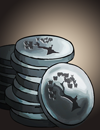
"The first taught restraint..."
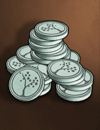
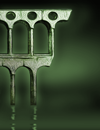
The First City, known as the Crossroads Shaded By Cedars, was located in Ancient Mesopotamia.[3] It may have been the Sumerian city of Uruk; some have debated, however, that it's the Akkadian/Hurrian city of Nagar (Tell Brak in modern Syria) in which the Eye Temple[4][5] mentioned in Fallen London is located. The remnants of the city live on in Polythreme. Ruins and artifacts of the First City can also be found in the Hinterlands, especially under the Magistracy of the Evenlode.
There are a few confirmed living survivors of the fall of the First City:
- The Manager of the Royal Bethlehem Hotel, its priest-king.[6] He may have inspired the myth of Gilgamesh (because of the latter's relationship with Enkidu and quest for immortality, with notable differences but some common themes), or perhaps he was merely an Akkadian/Hurrian king. The Manager is responsible for the fall of the First City, as he exchanged it for the life of his dying lover.[7]
- Polythreme's King With a Hundred Hearts. If the Manager is an allusion to Gilgamesh, then the King is Enkidu, Gilgamesh's closest friend in the epic. However, the King himself tells of originally being a merchant from China[8], rather than being a creature of clay the whole time like Enkidu, and his relationship with the Manager was explicitly romantic. The merchant was dying of "fits", so the Manager brokered a deal with the Masters of the Bazaar to save his life. They accomplished the task by shoving a large jewel from the Mountain of Light into his chest, creating his current form.
- The Capering Relicker, who was the first to brew Hesperidean Cider. He is the Manager’s uncle.[9]
- The Cladery Heir's mother is from the First City, and she is spoken of as if she were still alive. She was the surgeon responsible for lobotomizing the Bazaar, removing its urge to deliver messages.
- The Yearning Custodian, who was born in the First City and initiated the Marvellous in the Third. He now resides in the Root of Need in Parabola, and is the Keeper of the Marvellous and chronicler of its history and rulings.
So-called First City coins, which apparently are recent fakes, are used in the Marvellous as a substitute for ’fragments of a primal power’. They are traditionally exchanged in sets of thirty, the number of silver coins Judas was paid for betraying Jesus.
The Second City, circa 1335 BCE
"Never mention the Second City to the Masters of the Bazaar. Mr Wines will look at you narrowly and give you its worst vintage. Mr Cups will fly into a rage. Mr Veils will harangue you for your discourtesy. Mr Iron will say nothing, only write down your name with its left hand."
"Certain of the Masters of the Bazaar - Mr Stones, Mr Apples and Mr Wines, and possibly others - seem to have a particular contempt for Egypt and the Egyptological. Perhaps they're simply reacting to the fashion for the Pharaonic that overcame London before the Descent. But it's unusual that they should care."
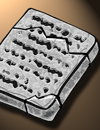
"...and the second betrayed..."
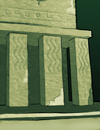
The Second City was Amarna, briefly the capital of ancient Egypt under Akhenaten. The remnants of the city live on in Visage and Arbor.
A living survivor of the fall of the Second City is the Duchess, a daughter of Akhenaten who orchestrated the fall ostensibly to save her lover's life. He was transformed into the Cantigaster by the Masters, saving his life from a snake bite at a heavy price. The princesses of the Second City "chained" the Bazaar in an event called the Treachery of Sands, leaving the Second City in place for millennia. Thanks to this, the city had an extremely antagonistic relationship with the Bazaar and the Masters, and many of its denizens also ran schemes that jeopardized the Bazaar's mission. The consequences of Amarna's long stay in the Neath would be felt later.
Four sisters of the Duchess also survived the Fall, but the eldest, Meritaten, sacrificed her life so that the Masters could be trapped in a tomb called the House of the Feather. Meketaten, the second of the six sisters, is the Obstinate Adoratrice, intent on finishing her older sister's work in building the Palace of the Rising in Parabola. The Mother Superior of Abbey Rock is the third; the Duchess is likely the fourth (though there is some older text mentioning that she is the youngest). The fifth, Neferneferure, became the first Roseate Queen of Arbor. The youngest sister, Setepenre, is said to have died on the Surface, as she did in real life.
Some of the Duchess's sisters still live yet, but their work will live on for much longer in Parabola, where the eldest two built the Skin of the Sun to house the Second City's refugees and shine cosmogone false-sunlight across the dream-realm.
The Third City, 800s-900s CE
"No-one talks much about the cities that preceded London. The Third City seems to have been acquired a thousand years ago. It had five wells, they say. And the weather was better."

"...The third taught us hunger..."
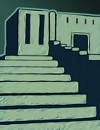
The Third City was Mayan. It may have been Chichen Itza, Tikal, or Calakmul; this last city is located next to the modern settlement of Hopelchén, whose name does mean "five wells". The majority of the Tomb-Colonies are built upon Third City architecture and mythology.
There are a handful of living survivors of the fall of the Third City: the First Curator and the God-Eaters, for example. To sink this city, the Masters offered the flesh of a god to the three leaders of this city, turning them into the monstrosities they are now. As for the god, let's just say it is very, very perturbed.
The Fourth City, 1254 CE
"Who carves horse-head amulets out of bone? Whoever lived in the Fourth City. If all the Fourth City amulets on sale are real, they must really have liked horses."

"...the fourth we remade..."
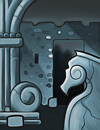
As confirmed in The Silver Tree, the Fourth City is Karakorum, once the capital of the Mongol Empire.
A living survivor of the fall of the Fourth City is the Gracious Widow (the daughter of Mongke Khan, whose real name is Cheren). It was her forbidden love for William of Paris, a European artist, that brought Mr Wines to the city. It's unclear whether Cheren or her father made the deal for the fall of the city, as The Silver Tree has multiple contradictory endings.
The remnants of the Fourth City live on in London's Forgotten Quarter, in Port Carnelian, in Arbor, and in the Khanate.
In the Sunless Skies timeline, after the gate to the High Wilderness at the Avid Horizon was opened, most Mongolian residents of the Neath passed through and established a new Khanate at Eagle's Empyrean.
The Fifth City, 1862 CE
"The city around the Bazaar is called the Fifth City because, they say, it's not the first the Bazaar chose as a home. You can still turn up bricks from the older cities, now and then. Look: here's one marked with an eye."
"...The fifth will live on in the heart of the Sun..."
There are numerous living survivors of the fall of London. It is widely known that Queen Victoria arranged the Fall to save her Prince Consort, as poor Albert was dying of typhoid fever. The Consort seems rather wan, however, and something else has already befallen the rest of the royal family...
The Sixth City, and the Seventh?
"The Masters have always been fond of Paris."
"...and the sixth..."

Paris will probably, assuming no one derails the Masters' plans, be the Sixth City. No wonder, for Paris is the City of Love.
As for the Seventh City, nothing is really known for sure - but rumors fly about Moscow...
Some content from NiteBrite; most information from http://community.failbettergames.com/topic23-fallen-cities-a-great-many-spoilers.aspx.
- ↑ Look down into the depths, Fallen London "Space is cleared as buildings crumble beneath the weight of the lacre, brick and stone and marble breaking into dust, churned up into the lacre and swallowed away."
- ↑ Look out across the zee, Fallen London "A group of desperate survivors throng once-grand docks. (...) The lacre tide rises and soon all is washed away."
- ↑ Crouching in a low stone building, Fallen London "the land between the Caspian and Mediterranean seas"
- ↑ Interview the Manager of the Royal Bethlehem, Fallen London "He used to be a king, ruling from a temple made of eyes"
- ↑ Looking for the manager, Fallen London "I received him in the temple of eyes"
- ↑ Looking in the garden, Fallen London "The priest-king wears white linen, and many layers of shining copper and brass jewellery. He is unmistakably the Manager of the Royal Bethlehem Hotel."
- ↑ Meeting the King, Fallen London
- ↑ Looking in the garden, Fallen London
- ↑ Hand over a roomful of scraps for a Coruscating Soul, Fallen London